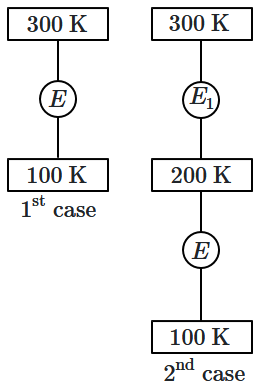Select Chapter Topics:
\(n\) moles of a perfect gas undergoes a cyclic process ABCA (see figure) consisting of the following processes.
| \(A\rightarrow B\) | Isothermal expansion at temperature \(T\) so that the volume is doubled from \(V_1\) to \(V_2=2V_1\) and pressure changes from \(P_1\) to \(P_2.\) |
| \(B\rightarrow C\) | Isobaric compression at pressure \(P_2\) to initial volume \(V_1\). |
| \(C\rightarrow A\) | Isochoric change leading to change of pressure from \(P_2\) to \(P_1\). |
Total work done in the complete cycle \(ABCA\) is:
1. \(0\)
2. \(nRT(\ln 2-\frac{1}{2})\)
3. \(nRT\ln 2\)
4. \(nRT(\ln 2+\frac{1}{2})\)
Subtopic: Work Done by a Gas |
60%
Level 2: 60%+
JEE
Please attempt this question first.
Hints
Please attempt this question first.
The same amount of heat is supplied to equimolar masses of hydrogen and helium, under constant pressure. The work done by the two gases, \(H_2\) and \(He,\) are \(W_1\) and \(W_2.\) Then:
| 1. | \(W_1>W_2\) |
| 2. | \(W_1<W_2\) |
| 3. | \(W_1=W_2\) |
| 4. | \(W_1\) and \(W_2\) cannot be compared unless the temperatures are known. |
Subtopic: Work Done by a Gas |
Level 3: 35%-60%
Hints
A monoatomic ideal gas undergoes a process given by the equation: \({\dfrac{pT}{V}}=\text{constant.}\) The molar specific heat capacity in the process equals:
| 1. | \({\dfrac{3}{2}}R\) | 2. | \({\dfrac{5}{2}}R\) |
| 3. | \({\dfrac{1}{2}}R\) | 4. | zero |
Subtopic: Molar Specific Heat |
Level 3: 35%-60%
Hints
The quantity of heat required to take a system from \(\mathrm{A}\) to \(\mathrm{C}\) through the process \(\mathrm{ABC}\) is \(20\) cal. The quantity of heat required to go from \(\mathrm{A}\) to \(\mathrm{C}\) directly is:
1. \(20\) cal
2. \(24.2\) cal
3. \(21\) cal
4. \(23\) cal
Subtopic: Cyclic Process |
Level 3: 35%-60%
Hints
A Carnot engine has an efficiency of \(50\%\). If the temperature of sink is reduced by \(40^{\circ}\text{C}\), its efficiency increases by \(30\%\). The temperature of the source will be:
1. \(166.7\) K
2. \(255.1\) K
3. \(266.7\) K
4. \(367.7\) K
1. \(166.7\) K
2. \(255.1\) K
3. \(266.7\) K
4. \(367.7\) K
Subtopic: Carnot Engine |
62%
Level 2: 60%+
Please attempt this question first.
Hints
Please attempt this question first.
Unlock IMPORTANT QUESTION
This question was bookmarked by 5 NEET 2025 toppers during their NEETprep journey. Get Target Batch to see this question.
✨ Perfect for quick revision & accuracy boost
Buy Target Batch
Access all premium questions instantly
An ideal monoatomic gas at a temperature of \(300\) K and a pressure of \(10\) atm is suddenly allowed to expand into vacuum so that its volume is doubled. No exchange of heat is allowed to take place between the gas and its surroundings during the process. After equilibrium is reached, the final temperature is:
| 1. | \(300\) K | 2. | \(\dfrac{300}{2^{5/3}}\) K |
| 3. | \(\dfrac{300}{2^{2/3}}\) K | 4. | \(600\) K |
Subtopic: Types of Processes |
Level 3: 35%-60%
Hints
Two monoatomic gases \(A,B\) are taken in two parts of a vessel having equal volumes \(V_0.\) The gases are at the same pressure \(P_0\) but at temperature of \(300~\text K\) and \(600~\text K.\) There is a partition between the parts of the vessel. The partition is removed, and the gases are allowed to mix. The vessel, as a whole, is insulated. The final temperature of the system is:

1. \(450~\text K\)
2. \(400~\text K\)
3. \(500~\text K\)
4. \(550~\text K\)

1. \(450~\text K\)
2. \(400~\text K\)
3. \(500~\text K\)
4. \(550~\text K\)
Subtopic: Work Done by a Gas |
Level 3: 35%-60%
Hints
In \(1^{\text{st}}\) case, Carnot engine operates between temperatures \(300\) K and \(100\) K. In \(2^{\text{nd}}\) case, as shown in the figure, a combination of two engines is used. The efficiency of this combination (in \(2^{\text{nd}}\) case) will be:


| 1. | same as the \(1^{\text{st}}\) case. |
| 2. | always greater than the \(1^{\text{st}}\) case. |
| 3. | always less than the \(1^{\text{st}}\) case. |
| 4. | may increase or decrease with respect to the \(1^{\text{st}}\) case. |
Subtopic: Carnot Engine |
Level 3: 35%-60%
JEE
Please attempt this question first.
Hints
Please attempt this question first.
A monoatomic gas \((A)\) and a diatomic gas \((B)\) are taken in two separate identical containers at the same conditions of temperature and pressure.
The two gases \(A,B\) are allowed to expand adiabatically until their volumes are doubled. The final temperatures are \(\theta_A\) (for gas \(A\)) and \(\theta_B\) (for gas \(B\)). Then:
The two gases \(A,B\) are allowed to expand adiabatically until their volumes are doubled. The final temperatures are \(\theta_A\) (for gas \(A\)) and \(\theta_B\) (for gas \(B\)). Then:
| 1. | \(\theta_A=\theta_B\) |
| 2. | \(\theta_A<\theta_B\) |
| 3. | \(\theta_A>\theta_B\) |
| 4. | the relationship between \(\theta_A,\theta_B\) depends on the molecular weights of \(A\) and \(B\) |
Subtopic: Types of Processes |
50%
Level 3: 35%-60%
Hints
An ideal gas forms the working substance of a Carnot engine, and is taken around the Carnot cycle. We form the integral: \(I=\int\dfrac{dQ}{T},\)
where \(dQ\) is the heat supplied to the gas and \(T\) is the temperature of the gas. The integral is evaluated over the entire cycle. The value of the integral \(I\) is:
where \(dQ\) is the heat supplied to the gas and \(T\) is the temperature of the gas. The integral is evaluated over the entire cycle. The value of the integral \(I\) is:
| 1. | zero |
| 2. | negative |
| 3. | positive |
| 4. | non-negative(positive or zero) |
Subtopic: Carnot Engine |
50%
Level 3: 35%-60%
Hints








